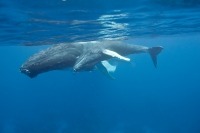
(Photo: Andrew J Martinez)
Humpback Whale
Megaptera novaeangliae
This species is dark grey-blue. They have many bumps on and around the snout. The white markings on their flukes can identify individuals. They are well-known for their "wings" (pectoral fins), which are about one-quarter to one-third of their body length. These fins provide them with great manoeuvrability compared to other whale species. Their average size is 14 metres, and average weight is 27 000 kilograms. Their blow can be up to three metres high and is heart shaped.
Authority
Borowski, 1781
Classification Details
Phylum: Chordata (chordates); Subphylum: Vertebrata (vertebrates); Class: Mammalia (mammals); Infraorder: Cetacea (whales and dolphins); Superfamily: Mysticeti (baleen whales).
Habitat
This is a global species, ranging from the polar regions to the tropics. They have the longest known migration of any mammal: up to 16 000 kilometres per year. Humpbacks inhabit high latitudes in the summer, where they spend the season feeding. They then migrate to lower latitudes, where they breed, in the winter. The North Atlantic population of humpbacks feed in four main areas during summer and fall: the Gulf of Maine (including Bay of Fundy), western Greenland, eastern Canada, and the eastern North Atlantic. In the winter they go to the Caribbean to mate and calve.
Diet
Humpback whales feed on plankton, krill, and small fish such as sand lances and anchovies. They do this by filtering water through their baleen plates. The hair-like edges of the baleen plates trap animals which are then licked off and swallowed. They have a variety of prey-trapping strategies. These include lunge feeding, where the whale surfaces with its mouth open, trapping a large volume of water and prey. Bubble netting is also used, where the whale blows bubbles while underwater. As the bubbles rise to the surface, they create a net of bubble columns that trap prey. Humpbacks can consume over 2 000 kilograms of food each day.
Reproduction
Sexes are separate. Females reach sexual maturity at 12 metres and males at 11.5 metres, when they are around five years old. Mating occurs during the winter months when southern North Atlantic waters are warmer. Males will court the females by singing to them. Females will give birth to one calf in warmer waters, almost a year after fertilization. After birth, the calf will nurse for about 10 months. Calves stay with their mothers for one to two years: the longest mother-calf bond of any baleen whale.
Fun Facts
We can identify humpback whales from the white marks on their tail flukes: these are unique to each individual. The Centre for Coastal Studies, in Provincetown, Massachusetts, manages a catalogue of Gulf of Maine humpbacks. This contains information on over 3 000 individual whales, including age, sex, and the number of offspring. When contributors sight an individual, they can send in photos. Scientists can then use the catalogue to identify individuals and study their movements. Huntsman staff and local whale watching operator, Quoddy Link Marine, contribute to the catalogue.
References
Eder T (2012) Whales and Other Marine Mammals of Atlantic Canada. Vancouver: Lone Pine Publishing.
Edel RK and Winn HE (1978) Observation on underwater locomotion and flipper movement of the humpback whale Megaptera novaeangeliae. Marine Biology 48, 279–287.
Miklosovic DS, Murray MM, Howle LE and Fish FE (2004) Leading edge tubercles delay stall on humpback whale (Megaptera novaeangeliae) flippers. Physics of Fluids 16(5), 39–42.
Perrin WF (2020) World Cetacea Database. Megaptera novaeangliae (Borowski, 1781). Accessed through: World Register of Marine Species at: http://www.marinespecies.org/aphia.php?p=taxdetails&id=137092 Accessed online 22 January 2020.
Waring GT, Josephson E, Maze-Foley K, Rosel PE (2016) Humpback Whale Gulf of Maine Stock. In: US Atlantic and Gulf of Mexico Marine Mammal Stock Assessments- 2015. NOAA Tech Memo NMFS NE 238; 501 p. https://www.nefsc.noaa.gov/publications/tm/tm238/22_f2015_humpback.pdf. Accessed online 22 January 2020.


